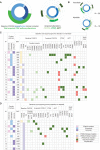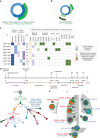Allosteric PI3Kα Inhibition Overcomes On-target Resistance to Orthosteric Inhibitors Mediated by Secondary PIK3CA Mutations
- PMID: 37916958
- PMCID: PMC10850944
- DOI: 10.1158/2159-8290.CD-23-0704
Allosteric PI3Kα Inhibition Overcomes On-target Resistance to Orthosteric Inhibitors Mediated by Secondary PIK3CA Mutations
Abstract
PIK3CA mutations occur in ∼8% of cancers, including ∼40% of HR-positive breast cancers, where the PI3K-alpha (PI3Kα)-selective inhibitor alpelisib is FDA approved in combination with fulvestrant. Although prior studies have identified resistance mechanisms, such as PTEN loss, clinically acquired resistance to PI3Kα inhibitors remains poorly understood. Through serial liquid biopsies and rapid autopsies in 39 patients with advanced breast cancer developing acquired resistance to PI3Kα inhibitors, we observe that 50% of patients acquire genomic alterations within the PI3K pathway, including PTEN loss and activating AKT1 mutations. Notably, although secondary PIK3CA mutations were previously reported to increase sensitivity to PI3Kα inhibitors, we identified emergent secondary resistance mutations in PIK3CA that alter the inhibitor binding pocket. Some mutations had differential effects on PI3Kα-selective versus pan-PI3K inhibitors, but resistance induced by all mutations could be overcome by the novel allosteric pan-mutant-selective PI3Kα-inhibitor RLY-2608. Together, these findings provide insights to guide strategies to overcome resistance in PIK3CA-mutated cancers.
Significance: In one of the largest patient cohorts analyzed to date, this study defines the clinical landscape of acquired resistance to PI3Kα inhibitors. Genomic alterations within the PI3K pathway represent a major mode of resistance and identify a novel class of secondary PIK3CA resistance mutations that can be overcome by an allosteric PI3Kα inhibitor. See related commentary by Gong and Vanhaesebroeck, p. 204 . See related article by Varkaris et al., p. 240 . This article is featured in Selected Articles from This Issue, p. 201.
©2023 The Authors; Published by the American Association for Cancer Research.
Figures




References
-
- Andre F, Ciruelos E, Rubovszky G, Campone M, Loibl S, Rugo HS, et al. Alpelisib for PIK3CA-mutated, hormone receptor-positive advanced breast cancer. N Engl J Med 2019;380:1929–40. - PubMed
-
- Savas P, Lo LL, Luen SJ, Blackley EF, Callahan J, Moodie K, et al. Alpelisib monotherapy for PI3K-altered, pretreated advanced breast cancer: A Phase II Study. Cancer Discov 2022;12:2058–73. - PubMed
MeSH terms
Substances
Grants and funding
LinkOut - more resources
Full Text Sources
Medical
Research Materials
Miscellaneous

